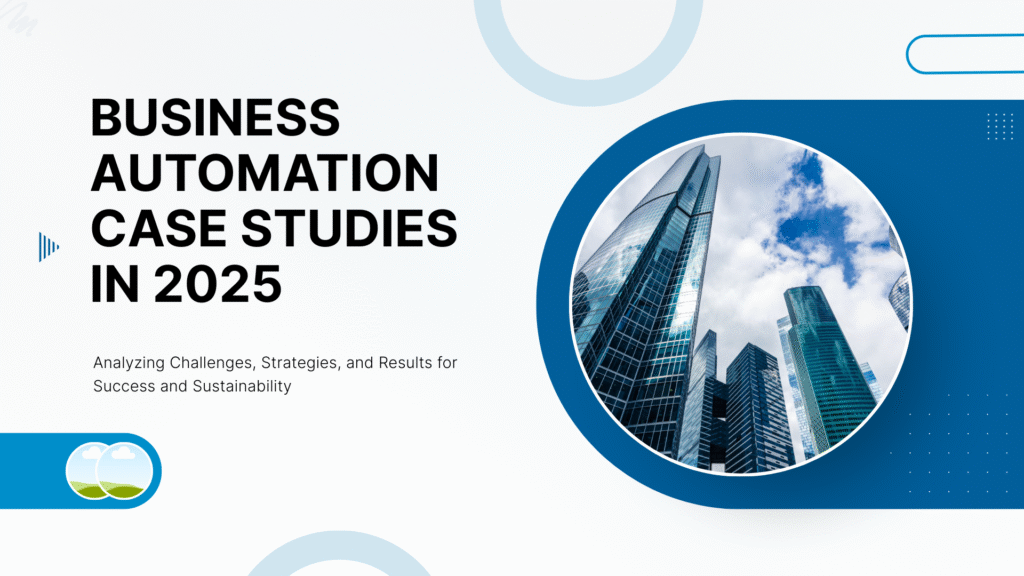Business Automation Case Studies: In today’s hyper-competitive business landscape, efficiency isn’t just a buzzword; it’s the bedrock of survival and growth. Businesses are constantly seeking ways to do more with less, streamline operations, and free up valuable human capital for more strategic initiatives. This is where business automation steps in, transforming how companies operate. But how does this translate into tangible results? The answer lies in exploring real-world business automation case studies.
This article will serve as your blueprint. We’ll delve into compelling business automation case studies, dissecting common business problems solved with automation, and demonstrating how businesses leverage business process automation to achieve remarkable efficiency and sustainable growth. By the end of this read, you’ll have a clear understanding of the power of automation and actionable insights to guide your own journey.
The Unseen Drain: Identifying Common Business Problems Solved with Automation
Before diving into specific case studies, let’s pinpoint the universal challenges that plague businesses and are ripe for automation. Recognizing these pain points is the first step towards identifying the right business automation solution for your organization.
- Repetitive Manual Tasks: Think data entry, invoice processing, scheduling, report generation. These tasks are not only time-consuming but also prone to human error, leading to costly mistakes and delays.
- Inconsistent Processes: Without standardized procedures, workflows can become chaotic, leading to bottlenecks, missed deadlines, and a frustrating experience for both employees and customers.
- Slow Customer Response Times: In the age of instant gratification, lengthy response times for inquiries, support requests, or order fulfillment can lead to customer churn.
- Information Silos: When data is scattered across different departments and systems, it hinders collaboration, impedes decision-making, and creates inefficiencies.
- Resource Misallocation: Highly skilled employees spending their time on mundane, administrative tasks are not being utilized to their full potential. This represents a significant opportunity cost.
- Scalability Challenges: As businesses grow, manual processes struggle to keep up, leading to overwhelmed teams and a potential slowdown in growth.

These are just a few of the common business problems solved with automation. Understanding these issues sets the stage for appreciating the transformative impact of automation demonstrated in the case studies below.
Business Automation Case Studies: Real-World Transformations
Let’s explore how various businesses have leveraged business automation to overcome challenges and achieve significant improvements.
Case Study 1: E-commerce Giant Streamlines Order Fulfillment
The Challenge: A rapidly growing online retailer was struggling with its order fulfillment process. Manual order picking, packing, and shipping were leading to:
- High error rates in order fulfillment.
- Increased shipping times, impacting customer satisfaction.
- Overtime costs for warehouse staff.
- Difficulty scaling operations during peak seasons.
The Automation Solution: They partnered with one of the leading business process automation companies to implement a comprehensive automation solution. This included:
- Automated Order Processing: Integration with their e-commerce platform to automatically pull order details.
- Robotic Process Automation (RPA) for Inventory Management: Bots were used to scan inventory levels, update stock counts in real-time, and flag low-stock items.
- Automated Shipping Label Generation: Integration with shipping carriers to generate labels and tracking information automatically.
- Warehouse Management System (WMS) Optimization: Implementing an automated WMS to guide pickers, optimize routes within the warehouse, and verify items.
The Results:
- Error Rate Reduction: Order fulfillment errors dropped by over 70%.
- Faster Shipping: Average shipping times were reduced by 2 days.
- Cost Savings: Significant reduction in overtime pay and fewer costly shipping mistakes.
- Scalability: The automated system effortlessly handled a 50% increase in order volume during the holiday season.
- Improved Customer Satisfaction: Higher on-time delivery rates and fewer order errors led to a noticeable uptick in positive customer reviews.
This case highlights how a well-designed business process automation solution can directly impact operational efficiency and customer experience.
READ MORE : 5 Game-Changing Tools Every Google AI Developers Should Know
Case Study 2: Financial Services Firm Enhances Customer Onboarding
The Challenge: A mid-sized financial services firm faced a lengthy and cumbersome customer onboarding process. This involved manual data verification, document collection, and account setup, resulting in:
- Long waiting periods for new clients.
- High administrative burden on the onboarding team.
- Risk of incomplete or inaccurate client information.
- Lost potential revenue due to slow onboarding.
The Automation Solution: The firm invested in a business automation strategy focused on digitizing and automating the onboarding workflow. Key elements included:
- Digital Application Forms: Online forms that automatically captured and validated customer data.
- Automated Document Verification: Using AI-powered tools to scan and verify identity documents and other required paperwork.
- RPA for Account Setup: Bots were programmed to create new customer accounts in various internal systems based on validated data.
- Automated Communication: Automated emails and SMS notifications to keep clients informed of their application status.
The Results:
- Reduced Onboarding Time: The onboarding process was shortened from an average of 5 days to just 1.5 days.
- Increased Productivity: The onboarding team could handle 40% more new clients without increasing headcount.
- Enhanced Data Accuracy: Automated validation significantly reduced data entry errors.
- Improved Compliance: Standardized, automated processes ensured all regulatory requirements were met consistently.
- Better Client Experience: A smoother, faster onboarding process led to higher client satisfaction and fewer drop-offs.
This business automation case study demonstrates how automating client-facing processes can be a significant competitive differentiator.
Case Study 3: Manufacturing Company Optimizes Procurement
The Challenge: A manufacturing company experienced inefficiencies in its procurement department, including:
- Manual requisition and purchase order creation.
- Lengthy approval cycles for purchase orders.
- Lack of visibility into spending and supplier performance.
- Missed opportunities for bulk discounts due to fragmented purchasing.
The Automation Solution: They collaborated with business process automation companies to implement a procure-to-pay automation solution. This involved:
- Automated Purchase Requisition System: Digital requisitions that routed automatically for approval based on predefined rules.
- RPA for Purchase Order Generation: Bots that created purchase orders from approved requisitions and sent them to suppliers.
- Automated Invoice Matching: Systems that automatically matched invoices against purchase orders and goods received notes.
- Centralized Procurement Dashboard: Providing real-time visibility into spending, supplier performance, and order status.
The Results:
- Streamlined Approvals: Purchase order approval times were cut by 60%.
- Reduced Errors: Fewer manual data entry errors in purchase orders and invoices.
- Cost Savings: Improved visibility enabled better negotiation with suppliers and identification of cost-saving opportunities, leading to an estimated 8% reduction in procurement costs.
- Enhanced Efficiency: Procurement staff could focus on strategic sourcing and supplier relationship management rather than administrative tasks.
- Improved Supplier Relations: Faster payment processing led to better relationships with key suppliers.
This showcases how business process automation can drive significant cost savings and strategic advantages in core operational areas.
Your Blueprint for Automation Success: Key Takeaways
These business automation case studies offer invaluable lessons for any organization looking to enhance efficiency and drive growth. Here are some actionable strategies to consider:
- Start with the Pain Points: Don’t automate for automation’s sake. Identify the most significant bottlenecks and inefficiencies within your organization. Where are the most errors occurring? What tasks are consuming the most time?
- Map Your Processes: Before you can automate, you need a clear understanding of your existing workflows. Document each step, identify inputs and outputs, and pinpoint areas for improvement.
- Prioritize Your Automation Efforts: Not all processes are created equal. Focus on automating high-volume, repetitive, and rule-based tasks first. These often yield the quickest ROI.
- Choose the Right Tools and Partners: The market for business automation tools is vast. Research thoroughly, consider your specific needs, and if necessary, partner with reputable business process automation companies who can provide tailored business automation solutions.
- Don’t Forget the Human Element: Automation is about augmenting human capabilities, not replacing them entirely. Involve your employees in the process, address their concerns, and retrain them for higher-value roles.
- Measure and Iterate: Once you implement an automation solution, track its performance closely. Measure key metrics, gather feedback, and be prepared to make adjustments. Continuous improvement is key.
Embrace Automation, Ignite Your Growth
The evidence is clear: business automation is no longer a luxury; it’s a necessity for sustained success. By learning from these business automation case studies and implementing strategic automation initiatives, you can overcome common business problems solved with automation, unlock new levels of efficiency, and position your organization for significant growth.
Are you ready to transform your operations? Start by identifying your most pressing inefficiencies and exploring how a tailored business process automation solution can pave the way for a more streamlined, productive, and profitable future. The blueprint for your efficiency and growth is within reach – it’s time to build it.
Follow us on








